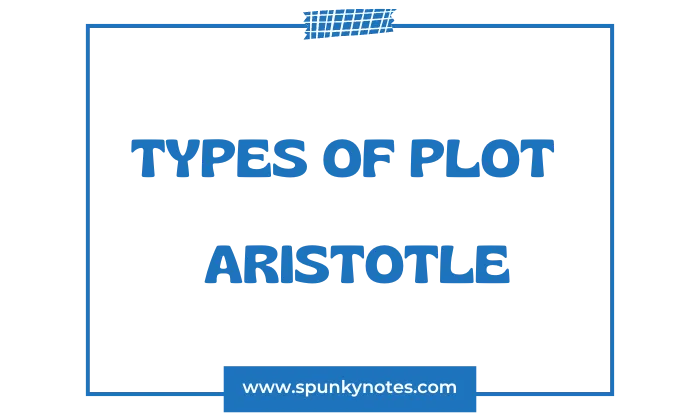

Estimated Reading Time: 7 min
Q. How does Aristotle define the plot and types of Plots in tragedy?
Aristotle, the ancient Greek philosopher, made significant contributions to the understanding of tragedy and drama through his work Poetics. One of the central elements he analyzed was the plot, which he believed to be the most critical part of a tragedy.
According to Aristotle, the plot is the arrangement of events in a story. It is not just a list of happenings but a carefully structured sequence of incidents that are logically connected.
For Aristotle, a good plot creates a sense of completeness and unity, which allows the audience to experience emotions like pity and fear, leading to catharsis or emotional release.
Aristotle’s Definition of Plot
Aristotle defined a plot as “the arrangement of incidents.” He viewed it as the “soul” of a tragedy, more important than characters, language, or spectacle.
The plot, then, is the first principle and, as it were, the soul of a tragedy; Character holds the second place. (Aristotle, Poetics)
For Aristotle, the plot was not simply a collection of events but the way those events were arranged to create a meaningful and emotional experience for the audience. Every event in the plot must be logically connected, with each action leading to the next.
According to Aristotle, a well-constructed plot has a beginning, middle, and end. These parts should be logically connected; nothing should feel out of place.
Components of a Plot
Aristotle explained that a good plot should have the following components:
Beginning: The beginning sets the stage for the story, introducing the characters, setting, and initial situation. It does not rely on prior knowledge and should provide enough information to start the story on its own.
Middle: The middle is where the story’s main action takes place. It is where complications arise, conflicts are introduced, and the story builds toward the climax. The middle must logically follow from the beginning and lead into the end.
End: The end resolves the conflicts and concludes the story. It should provide closure to the story’s events and leave the audience with completeness. The end must logically follow from the middle and tie up loose ends in the plot.
Unity of Action
One of Aristotle’s most important principles was the “unity of action.” This means the plot should focus on a single main action or story. All events should contribute to this central action without unrelated subplots or digressions.
Aristotle believed that unity of action was essential to keeping the audience engaged and creating an emotional response. If the plot was scattered or included unnecessary events, the audience’s attention would be divided, weakening the overall impact.
Kinds of Plot
Aristotle identified two main kinds of plots:
- Simple plots
- Complex plots
He considered the plot the most essential element of a tragedy because it determines how the story unfolds and how the audience reacts emotionally.
1. Simple Plot
A simple plot follows a direct sequence of events where the hero’s actions lead to the resolution of the story without any major twists or surprises.
In this type of plot, events are connected straightforwardly, and the story progresses logically from one action to the next. The outcome is predictable, and no significant reversals or recognitions alter the story’s direction.
Although a simple plot can still evoke emotions, Aristotle believed it lacked a complex plot’s depth and emotional intensity.
The straightforward nature of a simple plot limits the audience’s emotional engagement because it doesn’t introduce the unexpected or the dramatic shifts that are essential to a more profound experience of tragedy.
2. Complex Plot
A complex plot is more intricate and involves sudden changes in the hero’s fortune and moments of recognition. Aristotle believed that complex plots are superior because they can evoke strong emotions and achieve catharsis, which is the purging or emotional release of pity and fear.
Two key elements of a complex plot are:
Reversal (Peripeteia): This is a sudden and unexpected change in the story’s direction, where the hero’s situation shifts dramatically from good to bad or sometimes from bad to worse. The reversal catches the audience by surprise, creating a robust emotional response.
Recognition (Anagnorisis): This occurs when the hero realizes a crucial truth about their situation, often related to their own actions or identity. Recognition typically happens too late to prevent the tragic outcome, deepening the emotional impact on both the hero and the audience.
The combination of reversal and recognition in a complex plot heightens the tension and emotional stakes. Aristotle believed that these twists create a sense of inevitability, where the audience feels both pity for the hero and fear that similar events could happen to anyone.
Complex Plot and Catharsis
Aristotle argued that the complex plot is more effective in achieving catharsis. Catharsis refers to the emotional release that the audience experiences after watching a tragedy. Aristotle believed that the primary purpose of tragedy was to evoke pity and fear in the audience and to bring about catharsis through these emotions.
In a complex plot, reversal and recognition allow for an emotionally charged story. The unexpected reversal shocks the audience, while the hero’s recognition of their role in their downfall adds an emotional intensity. It creates a more profound sense of pity and fear than a simple plot.
Pity
The audience feels pity for the hero because their downfall is often undeserved or at least partially the result of forces beyond their control. In a complex plot, the hero’s reversal of fortune intensifies this pity because the audience sees how quickly and unexpectedly the hero’s life changes.
Fear
The audience experiences fear because they recognize that the hero’s fate could easily happen to anyone. The recognition in the plot shows how human mistakes or flaws can lead to disastrous consequences, evoking a sense of vulnerability and fear in the audience.
Episodic Plots
In contrast to simple and complex plots, Aristotle criticized episodic plots for their lack of unity and coherence. The events are loosely connected in episodic plots, and there is no clear cause-and-effect relationship between them.
Aristotle believed that episodic plots were less effective because they did not engage the audience as deeply and failed to create the emotional build-up necessary for catharsis. He argued that the best plots are those in which each event follows logically from the one before it, creating a sense of inevitability and emotional tension.
Plots Beginning In Medias Res
Aristotle also discussed beginning a story in medias res, which means starting the plot “in the middle of things.” Rather than starting at the chronological beginning, in medias res throws the audience directly into the middle of the action.
While the plot may start in the middle, it must maintain unity and coherence, with flashbacks or explanations provided to fill in the gaps.
Although Aristotle did not directly link in medias res to complex plots, this technique is often used in stories with complex plots because it allows the writer to reveal key events gradually, keeping the audience engaged and maintaining tension throughout the story.
Conclusion
In Poetics, Aristotle emphasized that the plot is the most essential element of tragedy, with complex plots superior for evoking strong emotions.
Through reversal and recognition, complex plots better achieve catharsis by deeply engaging the audience’s sense of pity and fear. According to Aristotle, this emotional release is the ultimate goal of a well-constructed tragedy.

